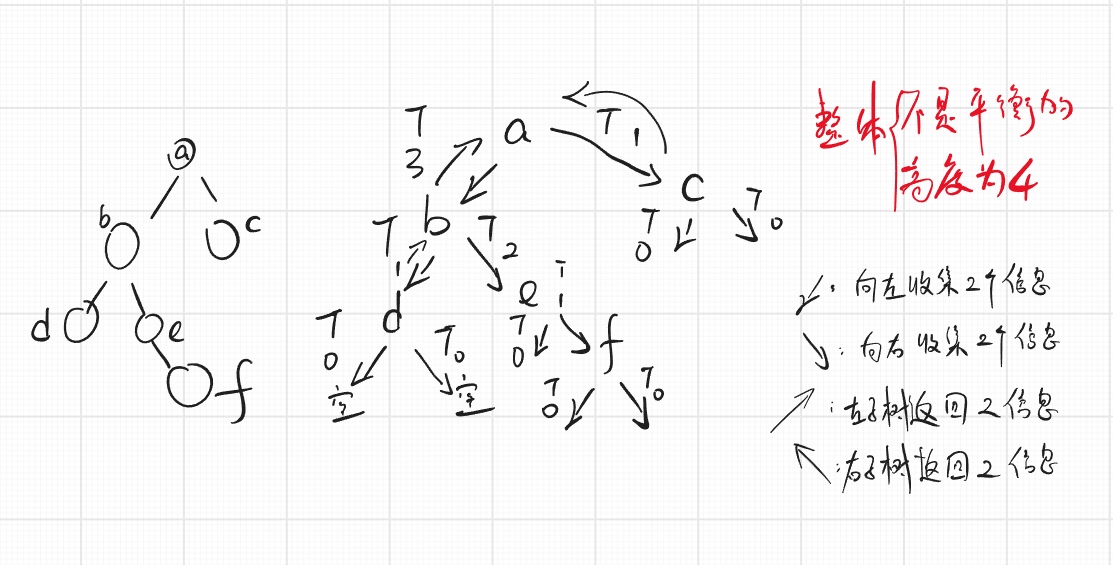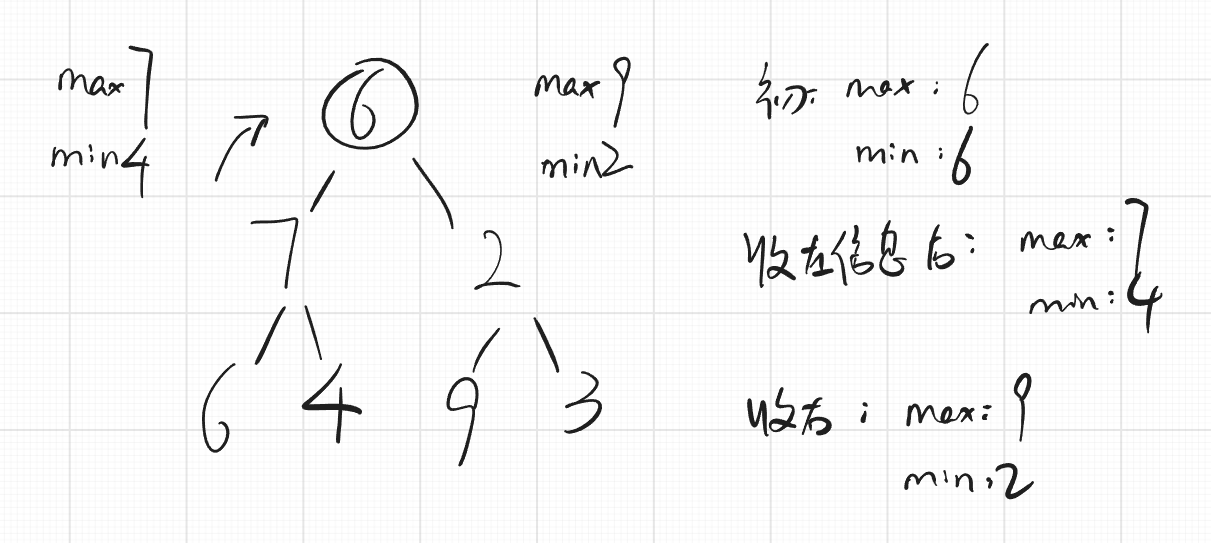网课LeetCode摘录
23. 合并多个有序链表
核心:小根堆
输入值:一堆头节点组成的链表
过程:
- 链表放入后,会把头节点按从小到大的顺序排序(小根堆)。
- 弹出时,把头节点指向的下一个数当成头节点,放入,新的头节点会和其他头节点进行比较,自动排序(小根堆)。
代码:
// 比较器:
public static class ListNodeComparator implements Comparator<ListNode> {
@Override
public int compare(ListNode o1, ListNode o2) {
// o1.val < o2.val , 则返回负数,也就是第一个参数在前面,小根堆。
return o1.val - o2.val;
}
}
// 主函数
public static ListNode mergeKLists(ListNode[] lists) {
if (lists == null) {
return null;
}
// 使用小根堆,把头挨个塞入,每次弹出后自动塞入头的下一个,进入后自动排序
// 需要自己写一个ListNode的比较器,也就是:ListNodeComparator
PriorityQueue<ListNode> heap = new PriorityQueue<>(new ListNodeComparator());
for (int i = 0; i < lists.length; i++) {
if (lists[i] != null) {
heap.add(lists[i]);
}
}
if (heap.isEmpty()) {
return null;
}
ListNode head = heap.poll();
ListNode pre = head;
if (pre.next != null) {
heap.add(pre.next);
}
while (!heap.isEmpty()) {
ListNode cur = heap.poll();
// 先拿到弹出节点的下一个
pre.next = cur;
pre = cur;
if (cur.next != null) {
// 如果刚刚弹出的节点的下一个,不是null,那就塞入
// 小根堆会自己比较
heap.add(cur.next);
}
}
return head;
}
100. 判断两棵树是否结构相同
public static boolean isSameTree(TreeNode p, TreeNode q) {
// 一个为空,一个不为空
if (p == null ^ q == null) {
return false;
}
// 都是空树
if (p == null && q == null) {
return true;
}
// 都不为空
// 头节点相同,左树相同,右数相同
return p.val == q.val && isSameTree(p.left, q.left) && isSameTree(p.right, q.right);
}
101. 判断一棵树是否是镜面树
public static boolean isSymmetric(TreeNode root) {
return isMirror(root, root);
}
public static boolean isMirror(TreeNode h1, TreeNode h2) {
// 头节点不会破坏镜面关系
if (h1 == null ^ h2 == null) {
return false;
}
// 头节点如果是空,自己和自己镜面没问题
if (h1 == null && h2 == null) {
return true;
}
return h1.val == h2.val && isMirror(h1.left, h2.right) && isMirror(h1.right, h2.left);
}
104. 返回一棵树的最大深度
// 以root为头的树,最大高度是多少,返回!
public static int maxDepth(TreeNode root) {
if (root == null) {
return 0;
}
// 需要返回的高度,是左子树的高度与右子树高度的最大值,并加上根节点的1
return Math.max(maxDepth(root.left), maxDepth(root.right)) + 1;
}
105. 用先序数组和中序数组重建一棵树
- 题目:https://leetcode.com/problems/construct-binary-tree-from-preorder-and-inorder-traversal
- 秘诀:画递归序的图图,假设具体的例子
- 代码:
public static TreeNode buildTree1(int[] pre, int[] in) {
if (pre == null || in == null || pre.length != in.length) {
return null;
}
return f(pre, 0, pre.length - 1, in, 0, in.length - 1);
}
// 有一棵树,先序结果是pre[L1...R1],中序结果是in[L2...R2]
// 请建出整棵树返回头节点
public static TreeNode f(int[] pre, int L1, int R1, int[] in, int L2, int R2) {
if (L1 > R1) {
return null;
}
TreeNode head = new TreeNode(pre[L1]);
if (L1 == R1) {
return head;
}
int find = L2;
// 遍历行为
while (in[find] != pre[L1]) {
find++;
}
head.left = f(pre, L1 + 1, L1 + find - L2, in, L2, find - 1);
head.right = f(pre, L1 + find - L2 + 1, R1, in, find + 1, R2);
return head;
}
public static TreeNode buildTree2(int[] pre, int[] in) {
if (pre == null || in == null || pre.length != in.length) {
return null;
}
HashMap<Integer, Integer> valueIndexMap = new HashMap<>();
// 统计中序数组中每个值在哪里
for (int i = 0; i < in.length; i++) {
valueIndexMap.put(in[i], i);
}
return g(pre, 0, pre.length - 1, in, 0, in.length - 1, valueIndexMap);
}
// 有一棵树,先序结果是pre[L1...R1],中序结果是in[L2...R2]
// 请建出整棵树返回头节点
public static TreeNode g(int[] pre, int L1, int R1, int[] in, int L2, int R2,
HashMap<Integer, Integer> valueIndexMap) {
if (L1 > R1) {
return null;
}
TreeNode head = new TreeNode(pre[L1]);
if (L1 == R1) {
return head;
}
// 在HashMap表中直接拿出来值,省去了遍历行为
int find = valueIndexMap.get(pre[L1]);
head.left = g(pre, L1 + 1, L1 + find - L2, in, L2, find - 1, valueIndexMap);
head.right = g(pre, L1 + find - L2 + 1, R1, in, find + 1, R2, valueIndexMap);
return head;
}
107. 二叉树按层遍历并收集结点
- 题目:https://leetcode.cn/problems/binary-tree-level-order-traversal-ii/
- 步骤
- 拿出此时队列的size,size有多少个,步骤2重复多少回;
- 弹出当前结点,当前结点有左孩子就先将左孩子加入队列,有右孩子再将右孩子加入队列;(先左再右)
- 代码:
public List<List<Integer>> levelOrderBottom(TreeNode root) {
// 选择LinkedList比选择ArrayList要好
List<List<Integer>> ans = new LinkedList<>();
if (root == null) {
return ans;
}
Queue<TreeNode> queue = new LinkedList<>();
queue.add(root);
while (!queue.isEmpty()) {
int size = queue.size();
List<Integer> curAns = new LinkedList<>();
// i<size不能是i<queue.size(),因为queue会变化,是动态的
for (int i = 0; i < size; i++) {
TreeNode curNode = queue.poll();
curAns.add(curNode.val);
if (curNode.left != null) {
queue.add(curNode.left);
}
if (curNode.right != null) {
queue.add(curNode.right);
}
}
// System.out.println(ans.toString());
// LinkedList的add (int index,E e)方法是在某个索引前插入元素E,
// 先根据索引index找到相应元素,在该元素前添加新元素,
ans.add(0, curAns);
}
return ans;
}
110. 平衡二叉树
- 题目:https://leetcode.cn/problems/balanced-binary-tree/
- 如何判断一颗二叉树是否是平衡二叉树? (二叉树题目 套路)
- 每一棵子树的
|左树高度-右树高度|<=1
- 每一棵子树的
- 图图解释:

- 代码:
// 以某个节点为头的时候
// 1. 整棵树是否平衡
// 2. 整棵树的高度是什么
public static class Info {
public boolean isBalanced;
public int height;
public Info(boolean i, int h) {
isBalanced = i;
height = h;
}
}
public static boolean isBalanced(TreeNode root) {
// 获得根节点两个信息中的isBalanced
return process(root).isBalanced;
}
public static Info process(TreeNode root) {
if (root == null) {
return new Info(true, 0);
}
// x!=null
// 获得左树两个信息
Info leftInfo = process(root.left);
// 获得右树两个信息
Info rightInfo = process(root.right);
// 获得整棵树的高度:左高与右高的最大值,再+1
int height = Math.max(leftInfo.height, rightInfo.height) + 1;
boolean isBalanced = leftInfo.isBalanced && rightInfo.isBalanced
&& Math.abs(leftInfo.height - rightInfo.height) < 2;
// 把根节点的两个信息返回
return new Info(isBalanced, height);
}
98. 验证二叉搜索树
- 题目: https://leetcode.cn/problems/validate-binary-search-tree/
- 如何判断一颗二叉树是否是搜索二叉树?
- 节点的左子树只包含 小于 当前节点的数。
- 节点的右子树只包含 大于 当前节点的数。
- 所有左子树和右子树自身必须也是二叉搜索树。
- 思路:
- 如果一个树的中序遍历结果严格递增,那就是有效的搜索二叉树
- 递归解法:
- 左是搜索二叉树;左max<x
- 右是搜索二叉树;右min>x
- 找出递归函数同等全的条件
- 每个节点返回三个信息
- 是不是搜索二叉树
- max
- min
- 图图解释:

- 代码:
// 递归函数同等全:都拿到三个信息
public static class Info {
public boolean isBST;
public int max;
public int min;
public Info(boolean is, int max, int min) {
isBST = is;
this.max = max;
this.min = min;
}
}
public static boolean IsBinarySearchTree(TreeNode root) {
return process(root).isBST;
}
public static Info process(TreeNode root) {
// root == null
if (root == null) {
// 可以返回0吗?不行,假如root的值是负数呢?想一下可以吗?
return null;
}
// root != null
Info leftInfo = process(root.left);
Info rightInfo = process(root.right);
// 假如上边有返回null的,这个地方就有压力了,你得解决null的情况呀!
int max = root.val;
int min = root.val;
if (leftInfo != null) {
max = Math.max(leftInfo.max, max);
min = Math.max(leftInfo.min, min);
}
if (rightInfo != null) {
max = Math.max(rightInfo.max, max);
min = Math.max(rightInfo.min, min);
}
// 首先我们默认为true;然后我们把所有违规的都列全,赋值为false,最后统一返回就可以。
// 这些情况有哪些呢?
// 1. 左树或右树有值的情况:看左树和右树是否满足搜索树的条件、看值是否符合条件。
// 2. 左树和右树都是null,直接返回true。
boolean isBST = true;
if (leftInfo != null && !leftInfo.isBST) {
isBST = false;
}
if (rightInfo != null && !leftInfo.isBST) {
isBST = false;
}
// 判读左树的最大值是否小于root的值。
boolean leftMaxLessX = leftInfo == null ? true : (leftInfo.max < root.val);
// 判读右树的最小值是否大于root的值。
boolean rightMinMoreX = leftInfo == null ? true : (rightInfo.min > root.val);
if (!leftMaxLessX || !rightMinMoreX) {
isBST = false;
}
return new Info(isBST, max, min);
}
x. 判断是否为平衡搜索二叉树
- 题目:
- 代码:
// 可以调两次判断,然后一与就完事了~
112. 路径总和
- 题目:https://leetcode.cn/problems/path-sum/
- 解释:
- 路径:从头节点开始,到叶节点结束,才叫做路径
- 代码:
public static boolean isSum = false;
public static boolean hasPathSum(TreeNode root, int sum) {
if (root == null) {
return false;
}
isSum = false;
process(root, 0, sum);
return isSum;
}
public static void process(TreeNode x, int preSum, int sum) {
// x是叶节点的时候
// baseCase:是叶节点的时候
// 只关心能不能到所有的叶节点
// 只有当x是叶节点的时候,才有可能把isSum = true;
if (x.left == null && x.right == null) {
if (x.val + preSum == sum) {
isSum = true;
}
// 返回值是void,目的是为了看有没有isSum = true;这个时刻发生
return;
}
// x是非叶节点,即将传值,把自己的值加上
preSum += x.val;
if (x.left != null) {
process(x.left, preSum, sum);
}
if (x.right != null) {
process(x.right, preSum, sum);
}
}
113. 总和 II
public static List<List<Integer>> pathSum(TreeNode root, int sum) {
List<List<Integer>> ans = new ArrayList<>();
if (root == null) {
return ans;
}
ArrayList<Integer> path = new ArrayList<>();
process(root, path, 0, sum, ans);
return ans;
}
public static void process(TreeNode x, List<Integer> path, int preSum, int sum, List<List<Integer>> ans) {
// basecase叶节点
if (x.left == null && x.right == null) {
if (preSum + x.val == sum) {
path.add(x.val);
ans.add(copy(path));
path.remove(path.size() - 1);
}
return;
}
// x 非叶节点
path.add(x.val);
preSum += x.val;
if (x.left != null) {
process(x.left, path, preSum, sum, ans);
}
if (x.right != null) {
process(x.right, path, preSum, sum, ans);
}
path.remove(path.size() - 1);
}
public static List<Integer> copy(List<Integer> path) {
List<Integer> ans = new ArrayList<>();
for (Integer num : path) {
ans.add(num);
}
return ans;
}
75. 颜色分类
- 题目:https://leetcode.cn/problems/sort-colors/
- 思路:快速排序第二版,分三区,并且按顺序
- 代码:
912. 排序数组
- 题目:https://leetcode.cn/problems/sort-an-array/
- 思路:采用快排.
- 代码:
public static void swap(int[] arr, int i, int j) {
int tmp = arr[i];
arr[i] = arr[j];
arr[j] = tmp;
}
// arr[L...R]范围上,拿arr[R]做划分值,
// L....R < = >
// 返回的是[L,R],把小区域的最小坐标和最大坐标返回
public static int[] partition(int[] arr, int L, int R) {
int lessR = L - 1;
int moreL = R;
int index = L;
while (index < moreL) {
if (arr[index] < arr[R]) {
// 当前值和小于区的下一个交换,小于区向右扩
swap(arr, ++l`essR, index++);
} else if (arr[index] > arr[R]) {
// 当前值和大于区的前一个交换,大于区向左扩
swap(arr, --moreL, index);
} else {
index++;
}
}
// 最后一个数,也就是划分值,归位
swap(arr, moreL, R);
// 小于区的最后一个+1,划分值归位的位置
return new int[]{lessR + 1, moreL};
}
// quickSort 递归版本
public static int[] quickSort1(int[] arr) {
if (arr == null || arr.length < 2) {
return arr;
}else{
process(arr, 0, arr.length - 1);
}
return arr;
}
public static void process(int[] arr, int L, int R) {
if (L >= R) {
return;
}
int[] equalE = partition(arr, L, R);
// euqalE[0] 等于区域的第一个数
// euqalE[1] 等于区域的最后一个数
process(arr, L, equalE[0] - 1);
process(arr, equalE[1] + 1, R);
}
x. …
- 题目:
- 代码:
x. …
- 题目:
- 代码:
x. …
- 题目:
- 代码:
x. …
- 题目:
- 代码:
x. …
- 题目:
- 代码:
All articles on this blog are licensed under CC BY-NC-SA 4.0 unless otherwise stated.